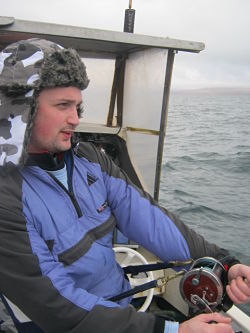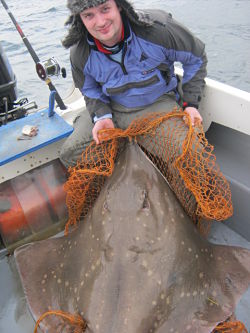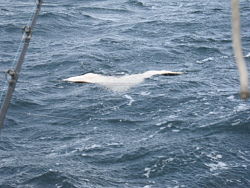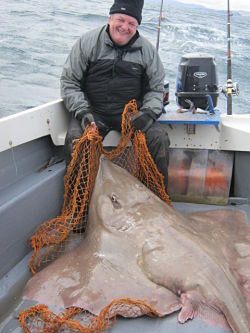Skating in Scotland
After working so hard on getting the new website up and running, Sandy had planned a week in Scotland visiting our son Lee in Edinburgh. Lee and I put our heads together and decided it needed to include a couple of days fishing. We had never fished in Scotland where several sea species can be caught that aren’t around in England so we decided to try and catch the biggest of the lot, the misnamed Common Skate. These fish were once common, but are now endangered and research to try to protect them can only be gleaned by anglers catching, tagging and then releasing them. It is hoped that this will locate the breeding grounds which can then be protected.
The first thing is to do research on where they are. Oban has been regarded as the best areas for several years but I am fortunate enough to have help in the form of marine Scientist Dr. Phill Williams who suggested I should go with Ian Burrett and his son Matt out of Crinan some 30 miles or so south of Oban.
The next thing to find out is when to do it. Ian and Matt go there for just over a month around April time believing that there is less food then and more competition so it gives you a little advantage. They can supply the tackle so we just arrived there on 2nd April for a crack at these gentle giants. You don't have to be a great angler, anybody can do it with the right skipper so if you fancy it, then contact them on ianburrett@btinternet.com
The weather had been excellent the week before setting record temperatures, and as we arrived, the weather, although not remaining that good was pleasantly overcast as we travelled only a short distance to the mark between the mainland and Jura in 450-500 feet of water. He weather cleared up as the day progressed and in the afternoon, we were taking off layers of clothing, hats and gloves we heated up.

 Lee spotted the first bite of the day, just a mere twitch on the rod top, so held it and waited for the line to tighten and then set the barbless hook. The skate then hugged the bottom and there it stayed for nearly half an hour. There is little point in over exerting yourself at this point as it makes little difference. He just kept the pressure until he could feel the skate head lifting then pulling back down. That was the time to really pump hard and “break the seal”. It was the just a matter of hauling the fish up several hundred feet to the surface. All in all it took about 45 minutes.
Lee spotted the first bite of the day, just a mere twitch on the rod top, so held it and waited for the line to tighten and then set the barbless hook. The skate then hugged the bottom and there it stayed for nearly half an hour. There is little point in over exerting yourself at this point as it makes little difference. He just kept the pressure until he could feel the skate head lifting then pulling back down. That was the time to really pump hard and “break the seal”. It was the just a matter of hauling the fish up several hundred feet to the surface. All in all it took about 45 minutes.
The skate was lifted into the boat, hook removed and then measured to ascertain the weight – 154lbs. This was a big fish and just what we had hoped to catch. The fish was already tagged so was then photographed and gently returned over the edge. Despite bait change, we couldn’t get another bite that day.
When we returned the next morning the weather had changed. We drove through snow flurries and the wind was gusting to 35 knots and it was VERY COLD with a choppy sea and good swell. This meant we had to head north to a different mark making best use of the islands to minimise the wind. What a difference. We baited up with a mackerel as previously and then waited for the bite. I am normally a good sailor, but the sea throwing around a small boat left me feeling seasick, despite trying to watch the horizon.
 I was feeling queezy when the rod suddenly buckled over. I was up in a flash, wound down to the fish and then set the hooks. We then entered the same fight as the day before; the fish wouldn’t budge. The only good point was the pressure of the battle kept you more steady in the boat and reduced the queeziness. I tried as hard as I could to break the sea with no success, the skipper warning me not to overload his rod. Fifty minutes later, the fish started to move and with some fast pumping, I managed to get her off the bottom. The boat was swinging from side to side in the wind which meant that the braid line was getting close to the keel and the outboard. I had to stretch to take the line behind the outboard to the other side and back at regular intervals which took a lot of physical effort as the boat swayed.
I was feeling queezy when the rod suddenly buckled over. I was up in a flash, wound down to the fish and then set the hooks. We then entered the same fight as the day before; the fish wouldn’t budge. The only good point was the pressure of the battle kept you more steady in the boat and reduced the queeziness. I tried as hard as I could to break the sea with no success, the skipper warning me not to overload his rod. Fifty minutes later, the fish started to move and with some fast pumping, I managed to get her off the bottom. The boat was swinging from side to side in the wind which meant that the braid line was getting close to the keel and the outboard. I had to stretch to take the line behind the outboard to the other side and back at regular intervals which took a lot of physical effort as the boat swayed.
 Eventually the skate came to the surface with its wings outstretched like a giant bird as it neared the boat. As before it was lifted in, measured and tag details taken. This one was even bigger – 193lb. I sat down next to the skate absolutely exhausted as Lee and Matt returned it before the seasickness got the better of me.
Eventually the skate came to the surface with its wings outstretched like a giant bird as it neared the boat. As before it was lifted in, measured and tag details taken. This one was even bigger – 193lb. I sat down next to the skate absolutely exhausted as Lee and Matt returned it before the seasickness got the better of me.
Lee than looked at me and said that we both have caught our fish and were delighted to get to see one and touch one. He said he didn’t want to catch another one and we should leave them in peace as we had the data from the catch. Even though we had booked the boat for the day, we decided to end the day there and head home.
I will always remember seeing a prehistoric fish in such beautiful surroundings, and hope I’ve done a little bit to help preserve this spectacular species.
I can’t finish without commenting on the fad of trying to catch one from a kayak. Whilst this might boost the ego, it is absolutely madness for the preservation of the species. The amount of tackle lost is significant which will kill the fish trailing it around the bottom, and the length of fight must also stress the fish ignoring the manhandling which must happen as the fish nears the boat for unhooking. I think this practice should be banned and to me is as stupid as line class records where the line is so light, all you do is chase fish around until they get too exhausted to continue and may well die.